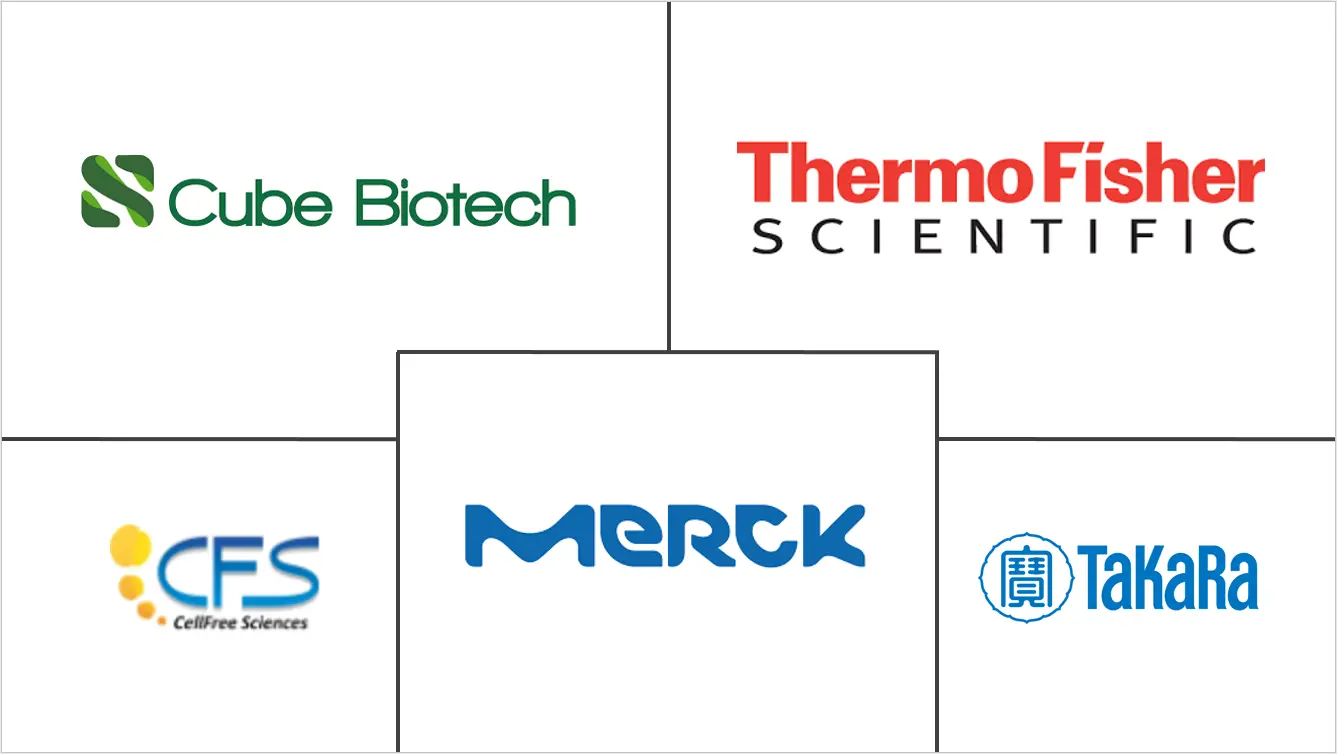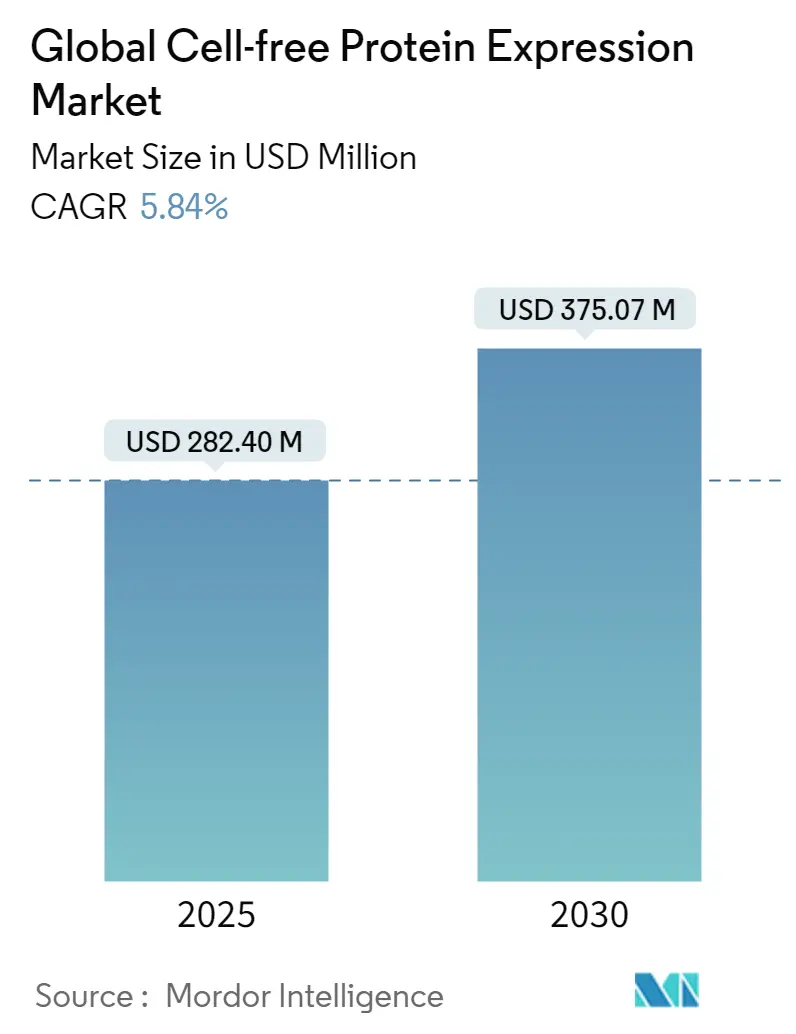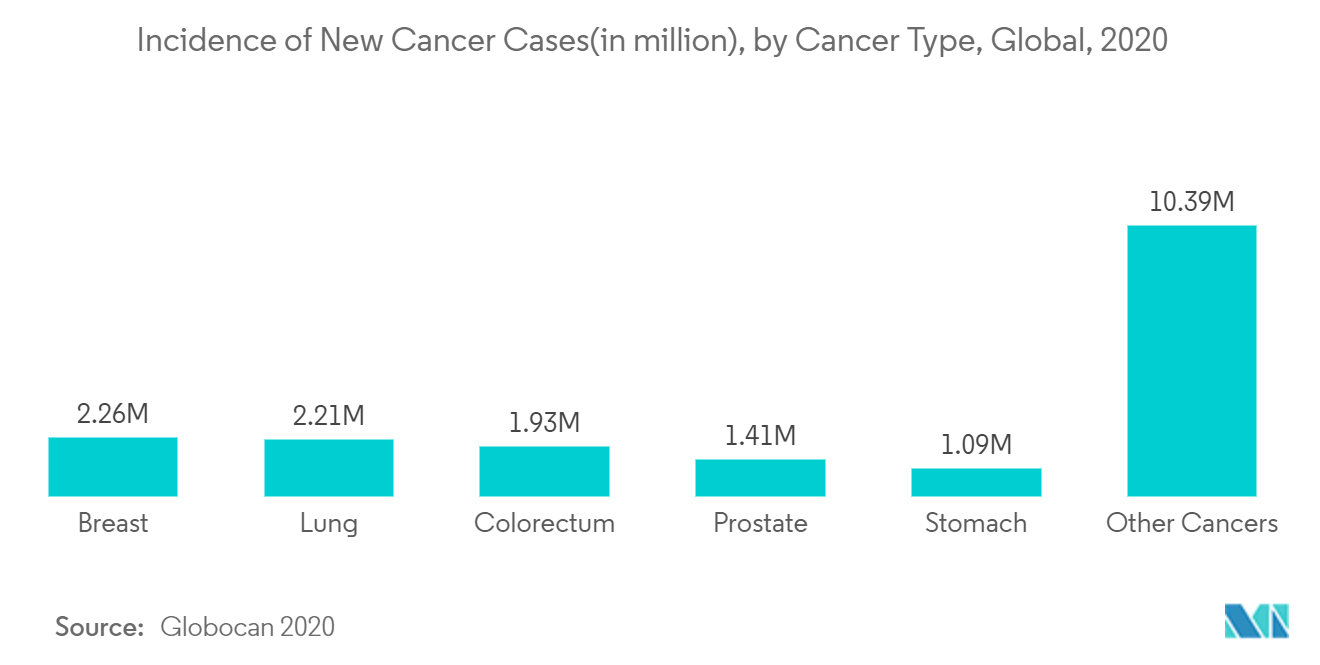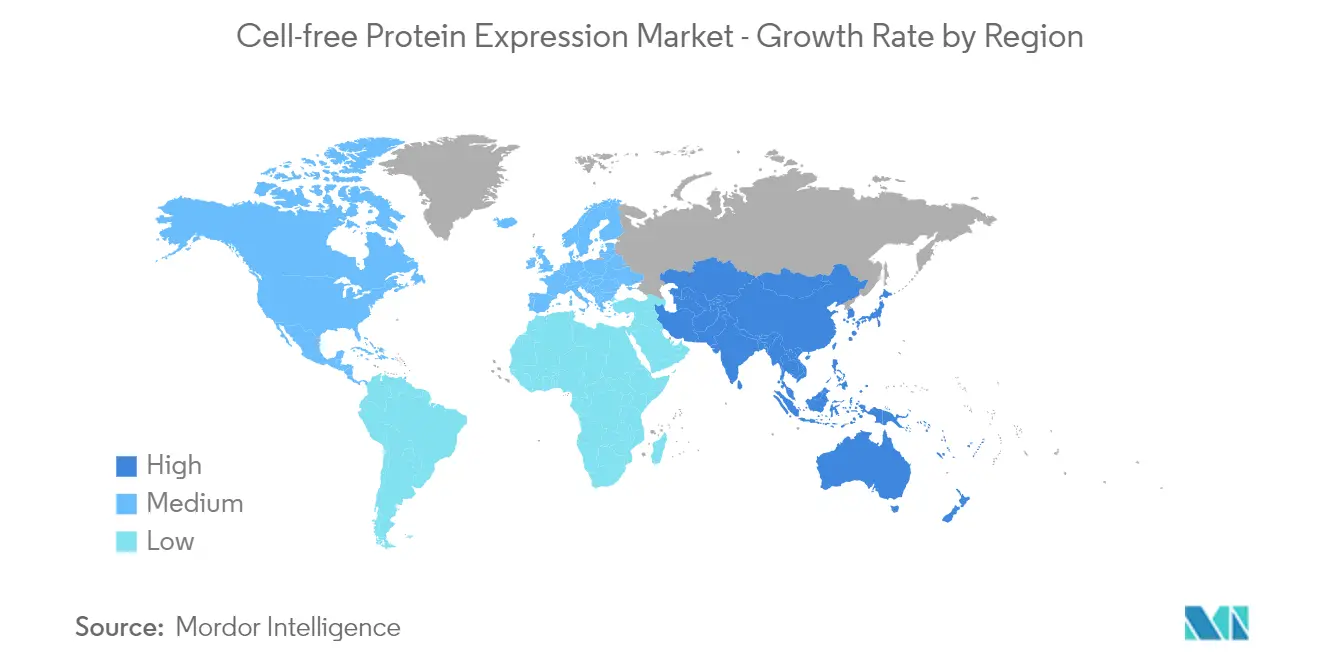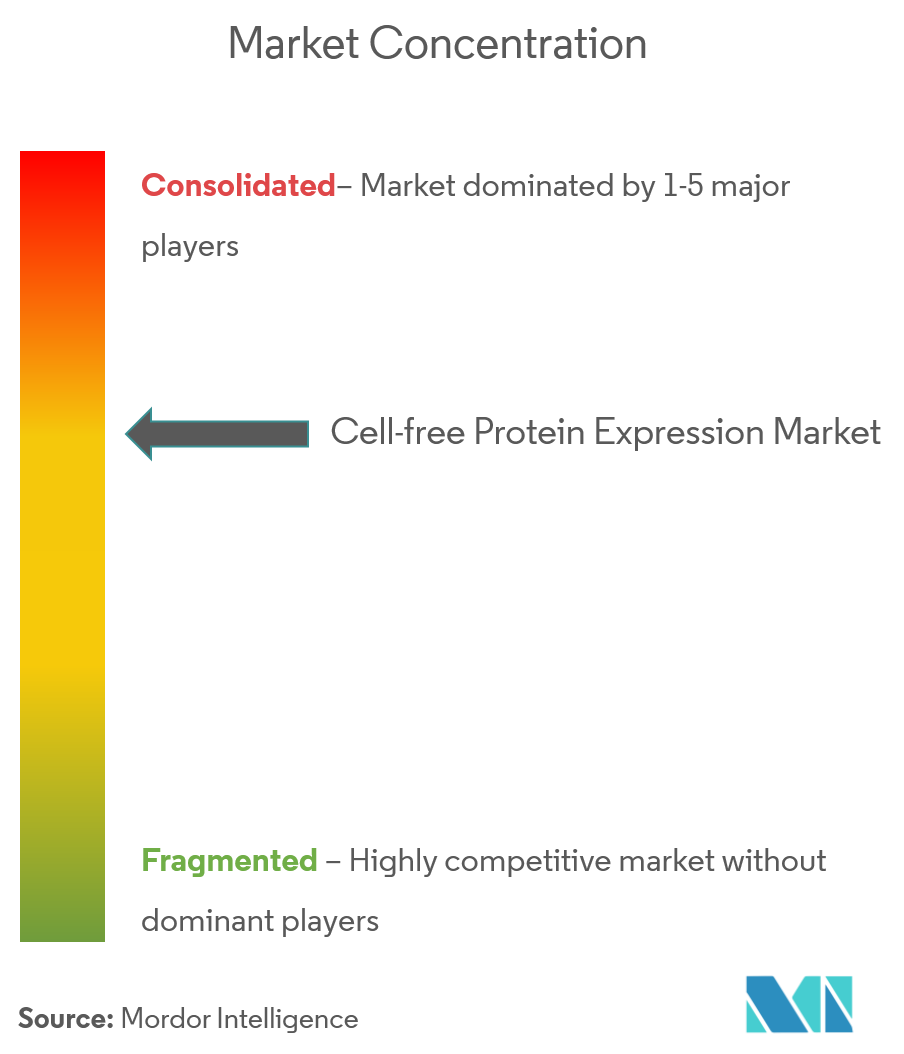Cell-free Protein Expression Market Analysis
The Global Cell-free Protein Expression Market size is estimated at USD 282.40 million in 2025, and is expected to reach USD 375.07 million by 2030, at a CAGR of 5.84% during the forecast period (2025-2030).
The market has a slightly positive impact due to the pandemic. Moreover, according to the article, "Harnessing Proteomics Could Improve Therapeutic Approaches to COVID-19," published in November 2020, the development of therapeutic and preventive strategies requires an accurate understanding of proteins' role in the SARS-CoV-2 infection process and progression of COVID-19.
Furthermore, according to the article, "Scientists Develop a High-Throughput, Cell-Free Screening Platform for Anti-SARS-CoV-2 Antibody Discovery," published in November 2021, therapeutic monoclonal antibodies developed against the spike protein of SARS-CoV-2 have become a promising intervention to treat severely ill Coronavirus Disease 2019 (COVID-19) patients. However, the isolation, evaluation, and identification of the best antibody candidate require a series of time-consuming and labor-intensive experiments, including cloning, transfection, cell-based protein expression, protein purification, and critical assessment.
The significant factors for the growth of the Cell-Free Protein Expression Market include the increasing R&D in proteomics and genomics, high prevalence of cancer and infectious diseases, and shorter expression time and structural modification. Cell-free protein expression employs cell lysates to produce the desired recombinant proteins, utilizing Cell Free Protein Synthesis methods. The primary advantage of this technique is the aversion of workflow hurdles of maintaining cell culture or living cells. Cell lysates are produced by the breakdown and use of cellular components of eukaryotic or bacterial cells. Several Cell-Free Protein Expression Systems are currently commercially available, based on E. coli, rabbit reticulocytes, wheat germs, human cell lines, and insect cells.
According to the article, 'Exploring the Potential of Cell-Free Protein Synthesis for Extending the Abilities of Biological Systems,' published in October 2019, Cell-Free Protein Synthesis (CFPS) has the potential to overcome loopholes in the current in vivo production systems and is a promising tool in both primary and applied scientific research. It facilitates a simplified organization of desired experiments with various reaction conditions, making CFPS a powerful tool in biological research. It has been used to expand genetic code, assembly of viruses, and metabolic engineering to produce toxic and complex proteins. Subsequently, CFPS systems have emerged as a powerful technology for the high-throughput Cell Free Protein Production of membrane proteins, enzymes, and therapeutics.
An in vitro protein expression system has significant advantages over living cell-based protein expression, including a shorter duration of the process, isotopic labeling of proteins, incorporation of non-natural amino acids, and optimization of protein complexes. In addition, the ability to enable high-throughput production, the recent trend of more research in personalized medicine, and the growing need for biological therapies to manage cancer is a significant driver for the growth of the In Vitro Protein Expression Market among pharmaceutical and biotechnology firms.
Cell-free Protein Expression Market Trends
The E. Coli Lysate Segment of the Lysate Systems is Expected to be the Fastest Growing Segment Over the Forecast Period
E. coli lysates are the most commonly used among all available commercial cell-free Protein Expression Systems. E. coli lysates are devoid of endogenous genetic messages and have advantages, such as very high protein yield and tolerability to most additives. Furthermore, E. coli-based systems are being used in Recombinant Protein Expression techniques for the manufacture of various biological therapeutics and insulin. Continuous use has enabled research on interactions and tolerability of the byproducts of E. coli-based systems, and significant present scientific literature enables its rapid adoption by industries and academics.
In E. coli-based systems, codons used are different, with some being eukaryotic specific. Additionally, post-translational modifications are not possible, which in turn limit the system's usage in the synthesis of specific human therapeutics, impacting the Human Protein Expression Market. Significant advancements have been, however, made in order to address these problems. Therefore, the E. coli lysate sub-segment is expected to register a steady growth rate during the forecast period, owing to high adoption rates and recent developments.
North America Dominates the Market, and It is Expected to do Same in the Forecast Period
North America is found to hold a major share in the Cell-Free Protein Expression Market, and it is expected to show a similar trend over the forecast period, without significant fluctuations. The primary factors behind the large market size include the increasing prevalence of chronic diseases, such as cancer, aging population, growing demand for targeted and personalized medicine, the presence of major R&D facilities, and favorable government initiatives in the United States. There is a growing trend of cell-based and Synthetic Biology research in the US academia and biotechnology industries. In recent years, several government initiatives have been supplementing the growth of the Cell-Free Protein Expression Market in the United States, further bolstering the Synthetic Biology Industry.
In the North American region, the United States holds the largest market share due to factors such as the increasing burden of cancer cases in the country, which is anticipated to stimulate the demand for the Cell Free Expression Market.
According to Globocan 2020, an estimated 2,281,658 new cancer cases were diagnosed in 2020, and 612,390 cancer deaths were reported in the United States. The increasing demand and acceptance of cell-free protein expression in the treatment of diseases such as cancer, rare diseases, and other disorders are also driving the growth of the studied market in the region.
Cell-free Protein Expression Industry Overview
The market studied is a moderately consolidated market, owing to the presence of small and large market players. Some of the key Cell Free Protein Synthesis Companies are Biotechrabbit GmbH, CellFree Sciences Co. Ltd, Cube Biotech GmbH, GeneCopoeia Inc., Jena Bioscience GmbH, Promega Corporation, Qiagen NV, Sigma-Aldrich Corporation (Merck KGaA), Takara Bio Inc., and Thermo Fisher Scientific Inc.
Cell-free Protein Expression Market Leaders
-
CellFree Sciences Co. Ltd
-
Cube Biotech GmbH
-
Thermo Fisher Scientific Inc.
-
Takara Bio Inc.
-
Merck KGaA
- *Disclaimer: Major Players sorted in no particular order
Cell-free Protein Expression Market News
- In January 2022, Merck KGaA acquired Exelead, a biopharmaceutical contract development and manufacturing organization (CDMO), for approximately USD 780 million.
- In January 2022, Thermo Fisher Scientific Inc. acquired PeproTech for approximately USD 1.85 billion. Through this acquisition, PeproTech's recombinant proteins portfolio will complement Thermo Fisher's cell culture media products and further enable Thermo Fisher to provide its customers significant benefits through an integrated offering.
Cell-free Protein Expression Industry Segmentation
As per the scope of this report, cell-free protein expression or in vitro protein synthesis is a process that involves the production of the recombinant proteins in cell lysate solution, without using cell culture or living cells. Cell-free protein expression can be carried out using different cell lysates, such as those of E. coli, rabbit reticulocytes, wheat germs, human cells, and insect cells. The cell-free protein expression market are segmented By Products, Accessories and Consumables , Lysate Systems (E. Coli Lysate, Wheat Germ Extract Lysate, Rabbit Reticulocyte Lysate, Insect Cell Lysate, Human Cell Lysate and Other Lysate Systems), By Application (Enzyme Engineering, High Throughput Production, Protein Labeling, Protein-Protein Interaction and Other Applications) and Geography (North America, Europe, Asia-Pacific, Middle East & Africa, and South America). The report offers the value (in USD million) for the above segments.
| By Products | Accessories and Consumables | ||
| Lysate Systems | E. Coli Lysate | ||
| Wheat Germ Extract Lysate | |||
| Rabbit Reticulocyte Lysate | |||
| Insect Cell Lysate | |||
| Human Cell Lysate | |||
| Other Lysate Systems | |||
| By Application | Enzyme Engineering | ||
| High Throughput Production | |||
| Protein Labeling | |||
| Protein-Protein Interaction | |||
| Other Applications | |||
| Geography | North America | United States | |
| Canada | |||
| Mexico | |||
| Europe | Germany | ||
| United Kingdom | |||
| France | |||
| Italy | |||
| Spain | |||
| Rest of Europe | |||
| Asia-Pacific | China | ||
| Japan | |||
| India | |||
| Australia | |||
| South Korea | |||
| Rest of Asia-Pacific | |||
| Middle-East and Africa | GCC | ||
| South Africa | |||
| Rest of Middle-East and Africa | |||
| South America | Brazil | ||
| Argentina | |||
| Rest of South America | |||
Cell-free Protein Expression Market Research FAQs
How big is the Global Cell-free Protein Expression Market?
The Global Cell-free Protein Expression Market size is expected to reach USD 282.40 million in 2025 and grow at a CAGR of 5.84% to reach USD 375.07 million by 2030.
What is the current Global Cell-free Protein Expression Market size?
In 2025, the Global Cell-free Protein Expression Market size is expected to reach USD 282.40 million.
Who are the key players in Global Cell-free Protein Expression Market?
CellFree Sciences Co. Ltd, Cube Biotech GmbH, Thermo Fisher Scientific Inc., Takara Bio Inc. and Merck KGaA are the major companies operating in the Global Cell-free Protein Expression Market.
Which is the fastest growing region in Global Cell-free Protein Expression Market?
Asia-Pacific is estimated to grow at the highest CAGR over the forecast period (2025-2030).
Which region has the biggest share in Global Cell-free Protein Expression Market?
In 2025, the North America accounts for the largest market share in Global Cell-free Protein Expression Market.
What years does this Global Cell-free Protein Expression Market cover, and what was the market size in 2024?
In 2024, the Global Cell-free Protein Expression Market size was estimated at USD 265.91 million. The report covers the Global Cell-free Protein Expression Market historical market size for years: 2019, 2020, 2021, 2022, 2023 and 2024. The report also forecasts the Global Cell-free Protein Expression Market size for years: 2025, 2026, 2027, 2028, 2029 and 2030.
Our Best Selling Reports
Global Cell-free Protein Expression Industry Report
Statistics for the 2025 Global Cell-free Protein Expression market share, size and revenue growth rate, created by Mordor Intelligence™ Industry Reports. Global Cell-free Protein Expression analysis includes a market forecast outlook for 2025 to 2030 and historical overview. Get a sample of this industry analysis as a free report PDF download.

